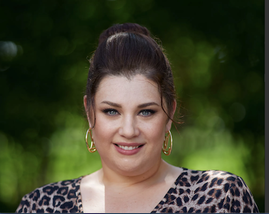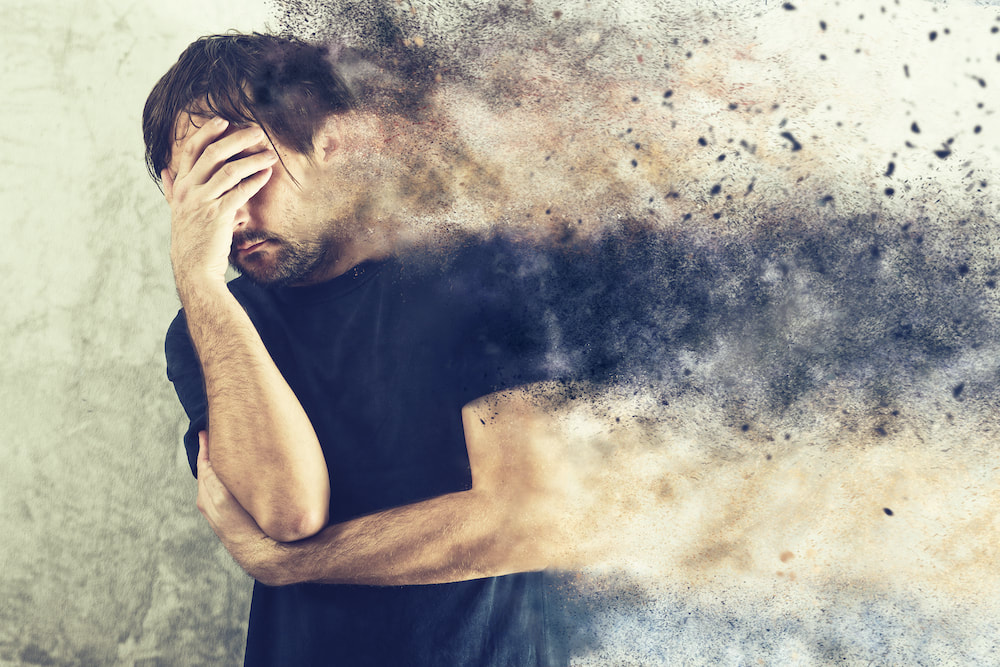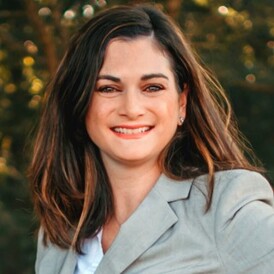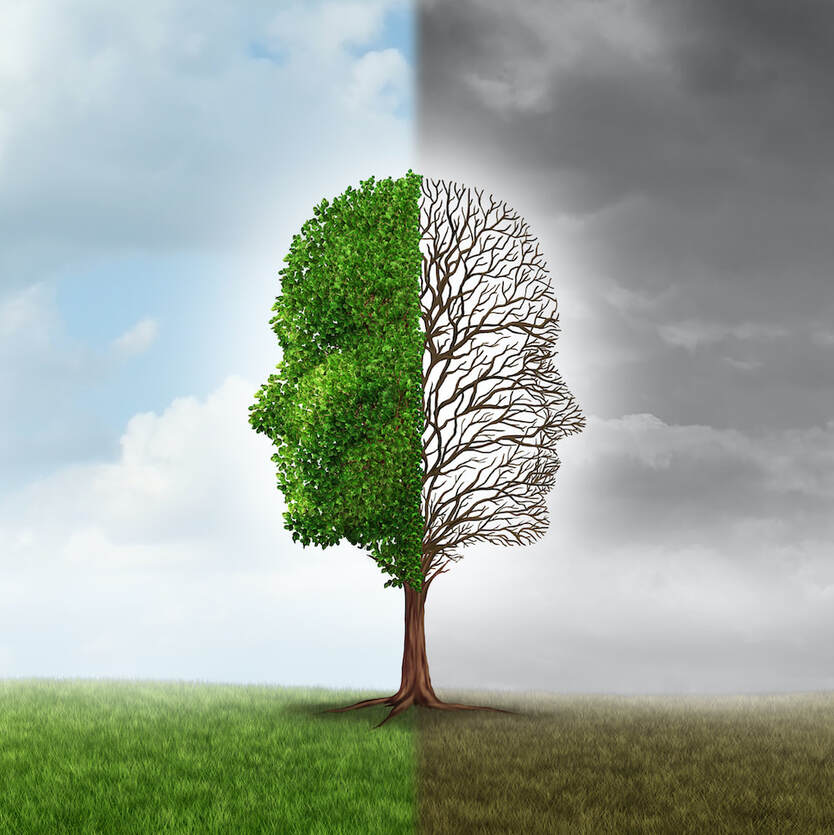|
I always knew I was different. A little too sensitive, a little too anxious, a little too much. As a child, I struggled with social anxiety and an obsessive need to please others. And, although I appeared to be a very happy child, something was starting to change in me. As a teenager I began to struggle with suicidal thoughts but was too afraid to tell anyone. I had been placed in therapy, but I was too scared to tell my therapist just how sad I was for fear of what would happen to me. my facade crumbles and my mental health along with itI once heard Jim Carey say that “depression” means “deep rest” and that a depressed mind is your body’s way of saying, “I need a break, I don’t want to play this character anymore.” That is exactly how I felt. I was physically and emotionally exhausted from trying to be happy all the time, trying to please others, and wearing a mask so that no one could see the real me and how much I was hurting. By the time I reached college, the façade that I had been holding up for so long came crumbling down and I had a full mental breakdown. I was forced to drop out of school and was eventually placed into McLean hospital as my behaviors became increasingly dangerous. I felt like I had failed everyone in my life and had failed myself. I no longer saw a bright future. I didn’t care anymore about anything, especially myself. Borderline personality disorder, anxiety, and depression diagnoses help me make sense of myself and my lifeI was hospitalized at 19 years of age and diagnosed with borderline personality disorder, anxiety and depression. Once I came to understand my diagnoses, the distorted way that I thought started to all make sense. I finally understood why I was such a people pleaser, why I was so terrified of being abandoned by my loved ones, why I was so afraid of anger, and why I had reached my breaking point. I started to realize that these illnesses had dictated so much of my thought processes that I didn’t even really know who I was. I lived in such paralyzing fear for most of my life, afraid to upset people and afraid to fail. I was exhausted. BEGINNING REAL WORK OF UNDERSTANDING WHERE MY ILLNESSES END AND I BEGinBut now the real work has begun: learning to understand where the illnesses end and where Dina begins. After spending ten years in and out of hospitals and rehab facilities, I was able to slowly reintegrate into mainstream society. I was able to go back to community college and then finish my Bachelor’s degree at Boston College while I worked a full-time job. The more I learned about myself, the more I began to realize just how smart I was, how kind I was, and what a great laugh I had. FULLY EMBRACING MY LIFE’S DREAMS, I Go for itWith a lot of grit and hard work, I was able to finally pursue the career path that I always envisioned for myself, landing internships and eventually a full time position working in television. I have achieved things that many thought were not possible for me and, even now, I need to constantly remind myself to be grateful for that. However, as we age and mature sometimes our dreams change and now, I am beginning to envision a whole new career path as a mental health empowerment keynote speaker. And once again, I plan to achieve that because I know that I can. my journey to recovery is a medal of honorI used to want to sweep the fact that I had endured a life-altering mental illness under the rug and just move on. I was ashamed and embarrassed of my past but now, I realize that I should NOT be ashamed of this. Rather, I should wear my journey to recovery like a medal of honor. I should be proud, and I should remind myself of that every day. A mental illness that alters your life never truly goes away but rather it lies dormant and reappears when life gets tough. I often try to control all aspects of my life because I have somehow convinced myself that if I can control life then it can’t throw me off the tracks. It can’t derail me and make me sick again. But that is not how life works. my light is A Beacon Reminding me We ARE All Perfectly ImperfectI am still learning to let go of the reins every once in a while, embracing the knowledge that even if life breaks me, I won’t stay broken forever. I am still actively in therapy and on a daily medication regimen. I fully support this because it allows me to lead a “normal” life. I still have issues that I struggle with daily, and I continue to work on myself every single day. Do I wish I was not an anxious person? Yes, of course! Do I wish I had not lost ten years of my life? Absolutely! But am I proud of the person I became? Undoubtedly! please heed my advice to youI once heard a quote, “when you go into the storm, you don’t come out the same person … you aren’t supposed to.” Mental illness is a storm but, like the quote says, you can come out of a storm, you just aren’t the same person who went into it. You are stronger and more resilient. My advice to you is this: don’t allow your mental illness to dictate what you are capable of. Only you can determine that. And remember, you are not flawed. You are not unlovable. You are not unworthy. You are perfectly imperfect. Go chase your dreams. You got this!
4 Comments
Why are FAMILIES and mental health advocates of loved ones WITH SERIOUS BRAIN DISORDERS fighting so hard FOR RECLASSIFICATION?Recently, the term Serious Brain Disorder (SBD) has been circulating in my Facebook mental health advocacy groups more and more. At first, it seemed as if these circles of advocates wanted the insurance companies to code Serious Mental Illnesses (SMIs) differently so they would issue better compensation to psychiatric providers and so patients could have easier access to treatment. In that case, I thought, why not address it with how the insurance companies are required to code them? But it starts elsewhere, beyond the insurance companies. As I explored and researched the issue, it became clear that taking Serious Mental Illnesses seriously must include labeling it transparently and as unbiased as possible. Here are several reasons why families and mental health advocates of loved ones with Serious Mental Illness—especially schizophrenia and the like—are fighting with all their hearts, souls, and minds to have it recognized as what it truly is: Serious Brain Disorder. First, What is SMI?The Diagnostic and Statistical Manual of Mental Illnesses defines Serious Mental Illness as “a small subset of the 300 mental illnesses that are in DSM.” “According to the National Institute of Mental Health, serious mental illness is relatively rare, affecting only 5% of the population over 18. Serious mental illness includes schizophrenia; the subset of major depression called ‘severe, major depression’; the subset of bipolar disorder classified as ‘severe’ and a few other disorders.”(4) One of the sources I interviewed pointed out that the general public doesn’t know what Serious Mental Illness is so reclassification would clarify the concept. On the other hand, I pointed out, wouldn’t that muddy the water? Not if they are educated. SBD EffortsAn organization advocating for the reclassification of SMI to SBD is the National Shattering Silence Coalition (NSSC). The nonprofit has eight points of unity members align under, and the first is their primary concern:
The Two Were Once OneThe two disciplines—neurology and psychiatry—are not as different as one may think. In fact, at one point they were one discipline. Historically, psychiatry and psychology were a part of neuropsychiatry until “psychiatrists enthusiastically embraced the key that they were given to the human psyche, and this new ‘mentalistic’ approach consequently detached psychiatry from neurology,” this article in neuro.psychiatryonline.org explains. “It may be further speculated that neurologists, too, accepted this dichotomy and were relieved to leave the treatment of mental illness to others.”(1) A Broken System Slighted and MisunderstoodMental health and the demand for psychotherapy and psychiatry are coming into the forefront on matters related to COVID-19’s mental toll on peoples’ psyches. However, advocates for SBD have been begging for practical solutions to a broken mental healthcare system long before the present worldwide crisis. Jeanne Allen Gore, SBD advocate, co-founder, and Coordinator of NSSC, argues that mental healthcare as an industry has been misconstrued, underfunded, and at a large disadvantage from neurology and pathology sciences and healthcare systems. Gore points out, “If you do the math, there is a glaring mismatch: $36.55 spent on adults with SBD compared to $478 on those with Alzheimer’s, which is 13 times, or 1,327% more per person.” According to Gore, other brain disorders like Alzheimer’s and autism have been inclined to more empathetic responses from the public. Since Alzheimer’s and autism have been funded and fought for their position at the table of medical sciences to be recognized as structural, biological, and medical brain disorders, it appears they garner more compassionate attitudes and legitimized views from society. The Science Has Been ThereIn the article at neuro.psychiatryonline.org, authors Shahar Arzy, M.D., Ph.D., and Shlomo Danziger, M.A. explain, “With our current scientific understanding of the cerebral basis of psychiatric disorders, the era of the computational, data, and genomic revolutions once again merges the domains of neurology and psychiatry for a neuroscientific-based diagnosis, monitoring, and treatment of neuropsychiatric diseases.”(1) In regards to SBDs like schizophrenia and symptoms like psychosis, science and technology are making ways to merge the disciplines of neurology and psychiatry. Especially in disorders like schizophrenia, severe depression, and severe bipolar disorder where psychosis is a symptom, these are brain-based and medical in nature. “More recent and dramatic evidence has come largely through functional magnetic resonance imaging and positron emission tomography,” per Mary G Baker, President, European Parkinson’s Disease Association as stated in Baker, Kale, and Menken.(2) Mary Palafox, RN, Chair of the Schizophrenia and Psychosis Action Alliance (S&PAA) states, “It’s not a debate whether schizophrenia is a neurological illness. Science has already determined schizophrenia to be a neuro-developmental disorder.” You can visit their website over the next few months and follow how S&PAA is actively changing the treatment paradigm for those with schizophrenia spectrum disorders. A Legal Loophole and Political ProblemsYet in practical solutions to psychosis in schizophrenia, psychiatrists cannot treat psychosis if the patient is not voluntarily admitted or concedes to treatment by their own will. In any other discipline, in a state of psychosis as a result of a medical condition, the doctors must treat, and their hands aren’t tied by laws. The danger of the legalities with SMIs or SBDs is what happens to many with SBD like schizophrenia when untreated, known as “dying with their rights on.” Jeanne Allen Gore writes: “People with neurological illnesses, under medical standards of care, have access to resources and supportive care that those diagnosed with a ‘mental illness’ do not have access to. Their doctor makes the decisions about what level of care is needed and when it’s needed, not a judge. For decades, the decision to admit a patient with SBD for medical care has been made based on laws requiring dangerousness and the availability of hospital beds, or should I say, lack thereof, rather than medical necessity.” She emphasizes, “This unconscionably cruel system has resulted in horrific abuses, neglect, and suffering. Our loved ones end up homeless, incarcerated, or dead far too soon. Science has proven these are no-fault, neurological brain disorders. Clinicians, doctors, and scientists know this. They are not a failure to control one’s behavior, a character weakness, or the result of a traumatic childhood.” Behavioral and mental health sciences have their value in psychosocial rehabilitation for substance use. Psychotherapy continues to be a respected and evidence-based approach for those with cognitive damage and disorders from substance use, trauma, and brain injury. The value of psychology and psychiatry cannot be ignored and compartmentalized, and there is a place for all these studies to effectively work together to help patients and those who care for them. It won’t be achieved as effectively and as successfully if true severe, serious mental illness, is not taken seriously in and of itself. To do that, action must be taken to move psychiatry and neurology back into a working relationship. The advances in science are here and there is enough evidence to show the validity of a medical cause of schizophrenia and these types of severe illnesses. The Bottom LineThe battle to have SMI recognized as SBDs continues, in order to be funded for more research to find better treatments and more physical tests connecting the symptomology of psychosis to the etiology (causes) of biological and physical structures. When the standard world health organizations take serious brain disorders seriously, then doors can open to more changes and better care. Then insurance payers can code them “medical” and doctors in hospitals and ERs will have to treat them as any other medical condition: with integrity, compassion, and ethics. Advocates for SBDs are pleading for this shift in terminology and semantics because of the severity of the illnesses and the brokenness of the system that currently treats those with them. With language that articulates that these disorders are brain-based and physical, reclassifying SMI to be recognized through medical standards can lead to better care and more practical solutions for individuals who suffer from it. This will level the playing field for equity in research and treatment funding, awareness campaigns, and give access to care and programs like #HousingThatHeals, just as Alzheimer’s and autism have achieved. With every discovery we make to understand mental illness, we will all inevitably have to face the reality that “mental” is medical. Reclassifying Serious Mental Illnesses as Serious Brain Disorders is the gateway to the broader acceptance of that reality. references
addendum from Kerry Martin, CEo & FounderAn added benefit of reclassification is removing the word "mental" from our narrative which would erode stigma in our society — in our workplaces, schools, social media, etc — saving lives and lessening suffering for our children, youth and adults struggling with their mental health. Stigma is trapping far too many behind its wall in silence and in shame, keeping those in need from reaching out for help. And, for those who believe we have made great strides in eradicating stigma, I would ask you, why hasn't our own Congress repealed a blatantly discriminatory law that has been on the books for almost 60 years, the IMD Exclusion, that has resulted in marginalizing our most vulnerable citizens, incarcerating them in our jails and prisons, walking over them on our cold streets, and pushing them into early graves?
1/3/2023 MYTHS Versus REALITIES OF Assisted Outpatient Treatment (AOT) FROM LENS OF mobile emergency psychiatric clinician ON FRONT LINESRead NowAssisted Outpatient Treatment (AOT) is a program under court order that motivates adults with serious mental illnesses who’ve had difficulty in adhering to voluntary treatment to engage in treatment. Civil courts and mental health agencies work together in AOT to reduce the frequency of inpatient hospitalizations and incarcerations. AOT encourages treatment teams to keep the recipients in treatment. An AOT request can be initiated as part of discharge planning on an inpatient unit, directly from an outpatient setting in the community, and upon release from jail or prison into the community. Forty-seven states and Washington D.C. allow AOT. Only three states, Maryland, Connecticut, and Massachusetts, lack AOT laws. Although AOT has become more accepted by mainstream society, controversy still exists because of myths. While I testified in favor of AOT at the state house in Massachusetts three times over the last several years, the strongest opposition came from peer specialists. AOT MYTHS versus realitiesMYTH: AOT is ineffective because there aren’t any consequences for treatment non-adherence. REALITY: Judges are not allowed to punish AOT recipients for non-adherence, but there can be consequences. The judge periodically meets with the recipient to reinforce the order. The length of the AOT program can be extended. The judge could order an emergency psychiatric evaluation. Rehospitalization on an inpatient unit might occur. MYTH: AOT is not person-centered and doesn’t align with the recovery model. REALITY: Although self-direction is limited at the beginning of the order, principles of the recovery model and person-centered care are used daily in AOT. Self-direction is preferred and should be maximized. Person-centered care can be emphasized even when recipients are not adhering to treatment. Using such an approach increases the chance of treatment adherence and positive outcomes. AOT does not necessarily lead to an increased sense of coercion. MYTH: AOT is too expensive. REALITY: Costs of AOT are small in comparison to the cost of inpatient care and incarceration. AOT is an evidence-based tool that typically results in fewer hospitalizations, fewer arrests, a decrease in homelessness, and fewer incarcerations. AOT saves money because hospitalization is far more expensive than outpatient care. MYTH: Comprehensive outpatient services that are voluntary would eliminate the need for AOT. REALITY: Many people with serious mental illness are incapable of engaging in treatment voluntarily because of their illness. Many of them have anosognosia, which is a lack of awareness of one’s own illness. By obligating mental health agencies and courts to engage them, AOT ensures that treatment interventions will be used for people who are most sick. AOT is a humane, reasonable, and evidence-based tool for people with psychosis who’ve had difficulty adhering to treatment. Widespread research has shown that AOT improves the overall functioning of its recipients. Addendum by Kerry Martin, CEO, accelerating social goodFor those interested in learning more about AOT and how it is used to help those most at risk for the negative and sometimes deadly consequences of not receiving treatment, additional reading follows:
GUEST AuthorLynn Nanos heads the Blogging Committee for National Shattering Silence Coalition Nonprofit, our pro bono client, and is also a member of their Steering Committee. She is a licensed independent clinical social worker employed as a full-time mobile emergency psychiatric clinician in Massachusetts. She evaluates patients in homes, jails, residential programs, day treatment programs, rest homes, hospital emergency rooms, and inpatient medical units, determining if patients are presenting a danger to themselves or others. She also authorizes and implements involuntary transfers of individuals to hospitals or refers them to residential treatment, outpatient care, or crisis stabilization units. |
Details
Archives
February 2023
Categories
All
|





 RSS Feed
RSS Feed